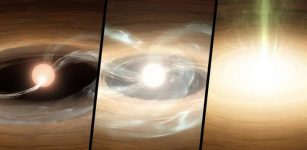NASA’s NuSTAR Observes Mysterious Flashes Of Green/Blue Spots In NGC 6946
Eddie Gonzales Jr. – MessageToEagle.com – NASA’s NuSTAR space observatory recently captured bright flashes of green and blue spots that appeared and disappeared in the Fireworks Galaxy (NGC 6946).
Generated by some of the most energetic processes in the universe, these X-ray sources are rare compared to the many visible light sources in the background image.
 This visible-light image of the Fireworks galaxy (NGC 6946) comes from the Digital Sky Survey, and is overlaid with data from NASA’s NuSTAR observatory (in blue and green). Credit: NASA/JPL-Caltech
This visible-light image of the Fireworks galaxy (NGC 6946) comes from the Digital Sky Survey, and is overlaid with data from NASA’s NuSTAR observatory (in blue and green). Credit: NASA/JPL-Caltech
A new study offers some possible explanations for the surprise appearance of the green source near the center of the galaxy, which came into view and disappeared in a matter of weeks.
The green blob near the bottom of the galaxy wasn’t visible during the first NuSTAR observation but was burning bright at the start of a second observation 10 days later.
“Ten days is a really short amount of time for such a bright object to appear,” Hannah Earnshaw, a postdoctoral researcher at Caltech in Pasadena, California, and lead author on the new study said in a press release.
“Usually with NuSTAR, we observe more gradual changes over time, and we don’t often observe a source multiple times in quick succession. In this instance, we were fortunate to catch a source changing extremely quickly, which is very exciting.”
NASA’s Chandra X-ray Observatory later observed that the source – known as an ultraluminous X-ray source, or ULX – had disappeared just as quickly.
Researchers rule out the possibility that it is also a supernova. The possibility is that the light came from a black hole consuming another object, such as a star. Most ULXs are typically long-lived because they’re created by a dense object, like a black hole, that “feeds” on the star for an extended period of time.
Short-lived, or “transient,” X-ray sources like ULX-4 are far more rare, so a single dramatic event – like a black hole quickly destroying a small star – might explain the observation.
The source of ULX-4 could be a neutron star. Neutron stars are extremely dense objects formed from the explosion of a star that wasn’t massive enough to form a black hole. With about the same mass as our Sun but packed into an object about the size of a large city, neutron stars can, like black holes, draw in material and create a fast-moving disk of debris.
These can also generate slow-feeding ultraluminous X-ray sources, although the X-ray light is produced through slightly different processes than in ULXs created by black holes.
Perhaps the researchers will never find the answer to the mysterious flashes but as Earnshaw said, the observation of this celestial event will contribute to understanding some of the rarer and more extreme cases in which matter accretes onto black holes or neutron stars.
Written by Eddie Gonzales Jr. – MessageToEagle.com Staff










